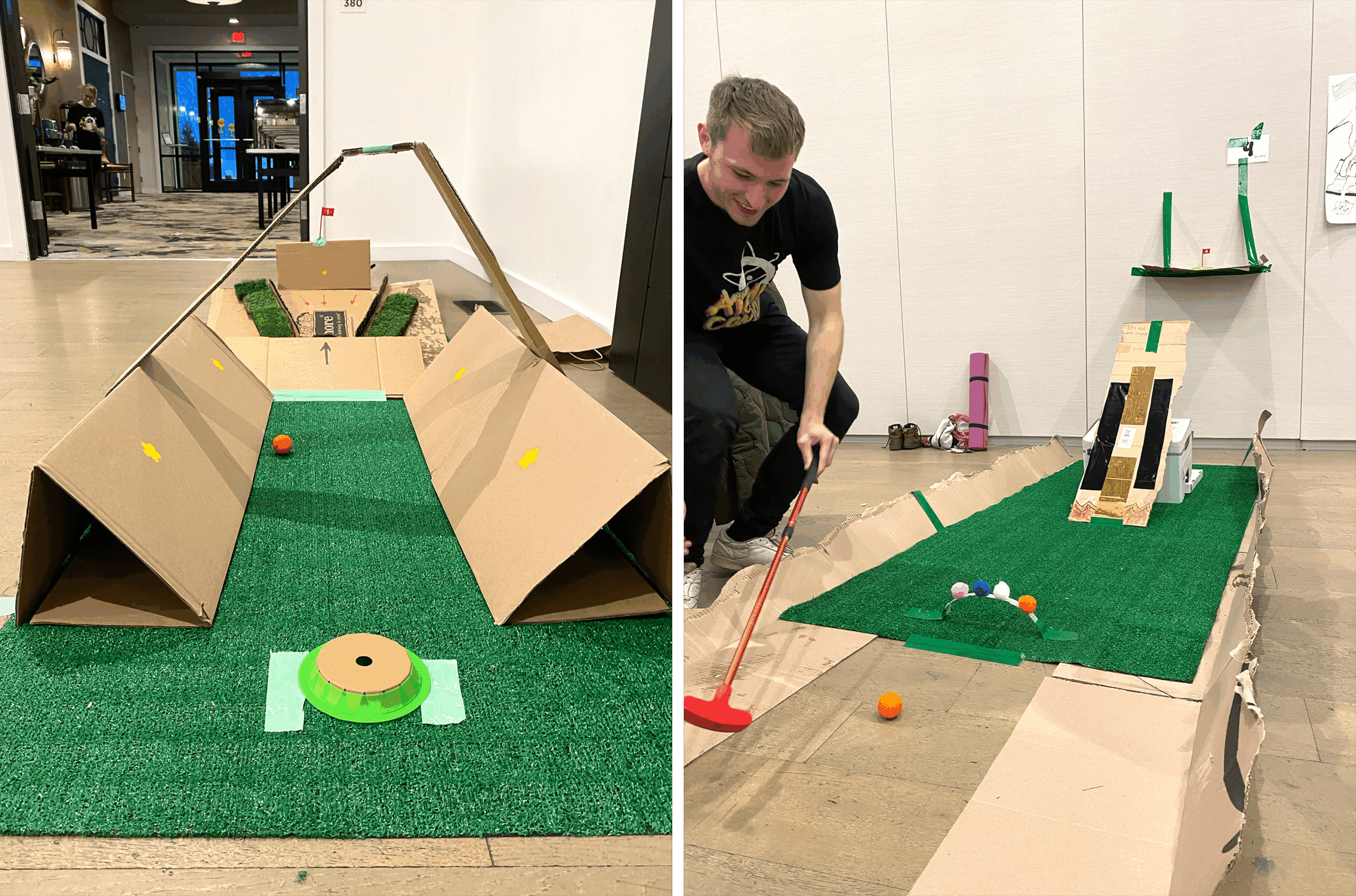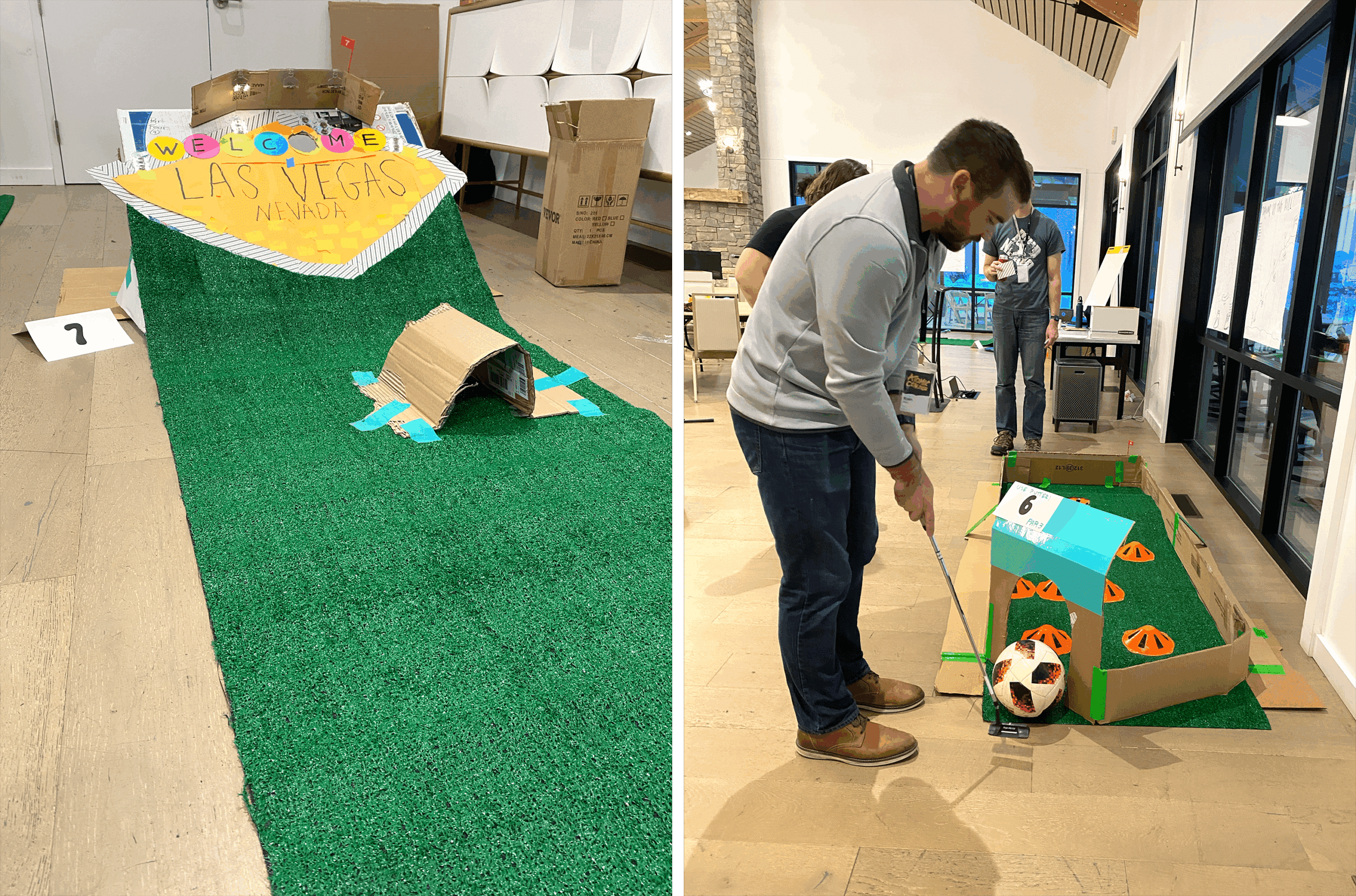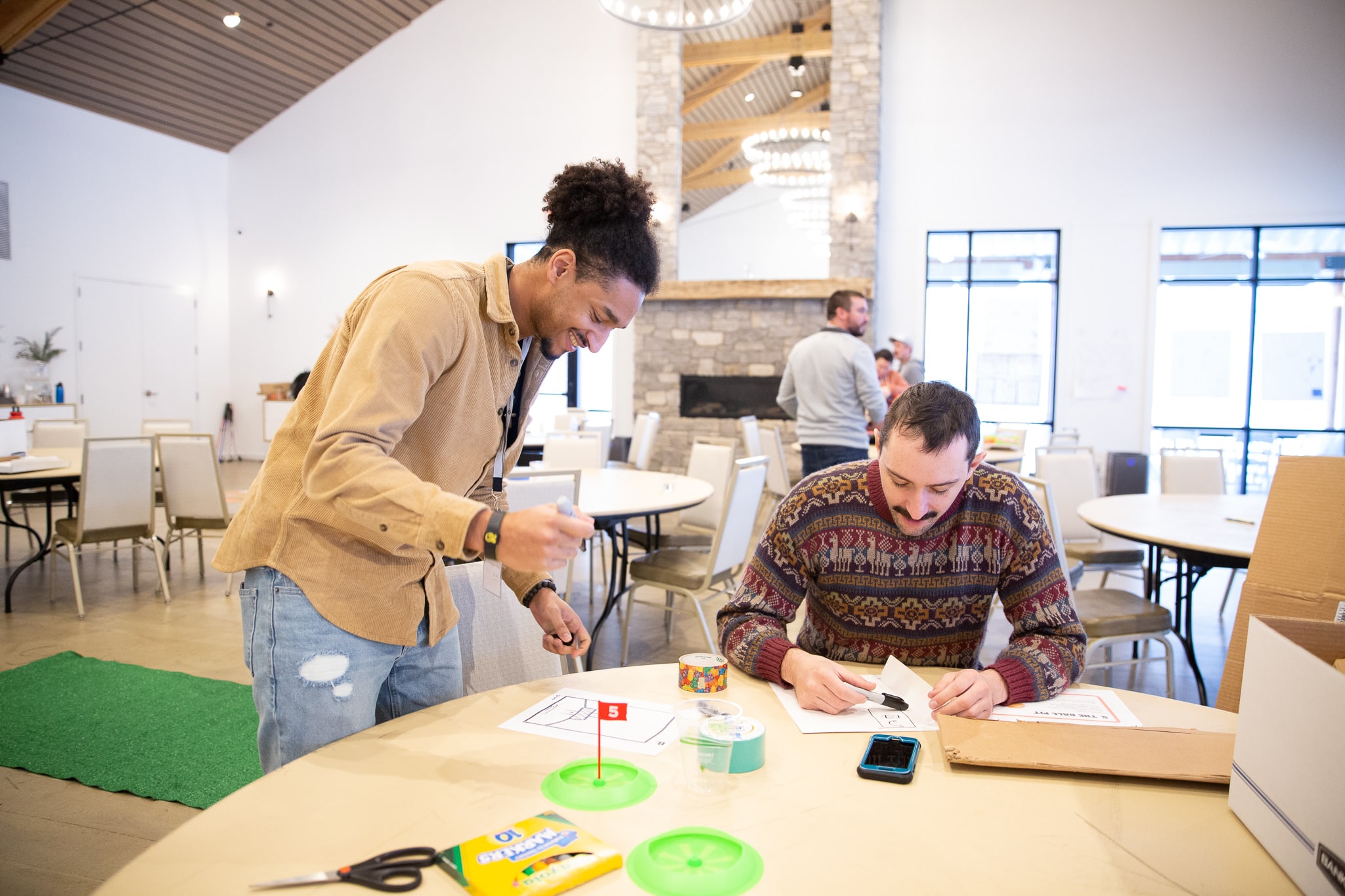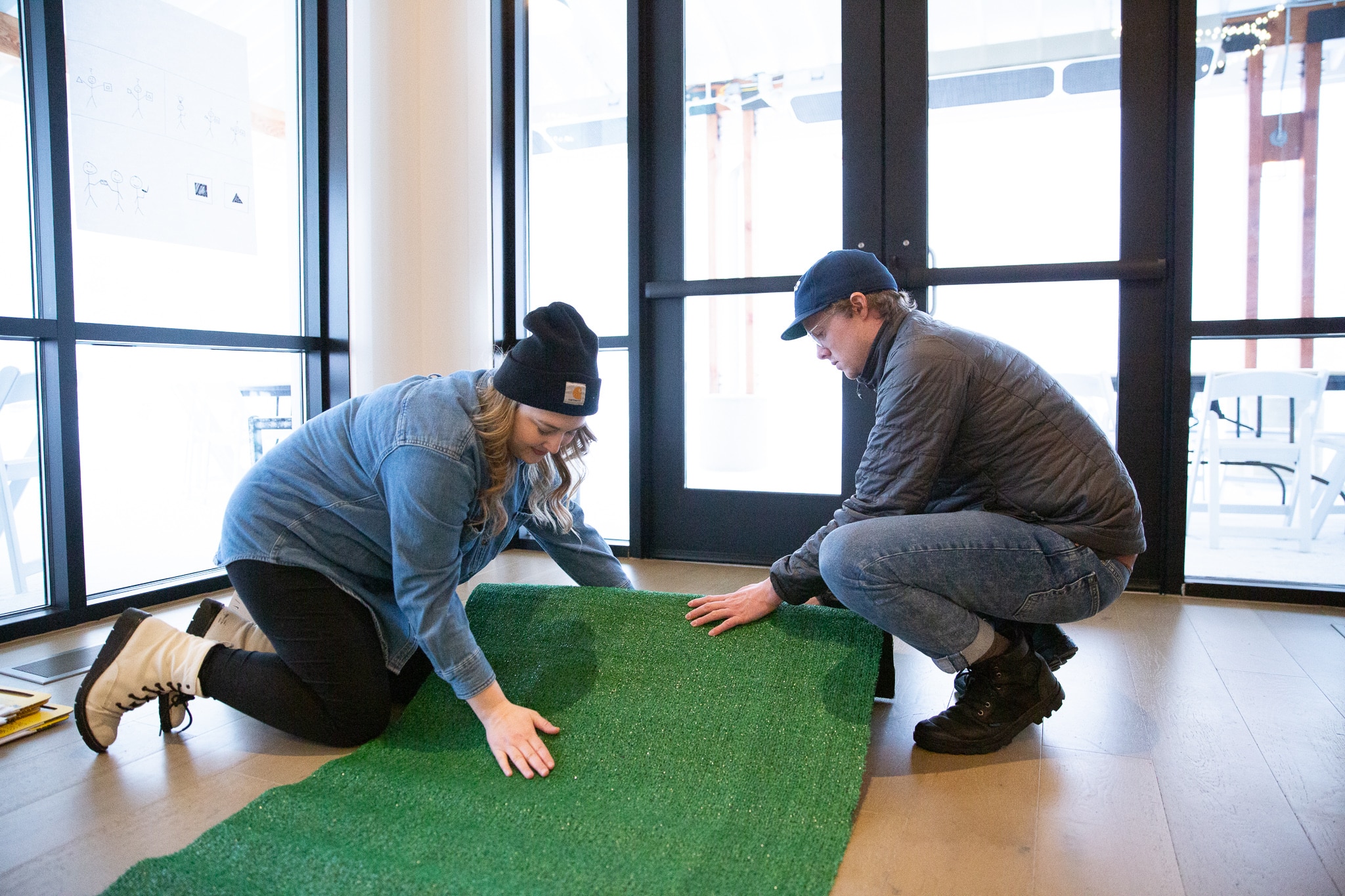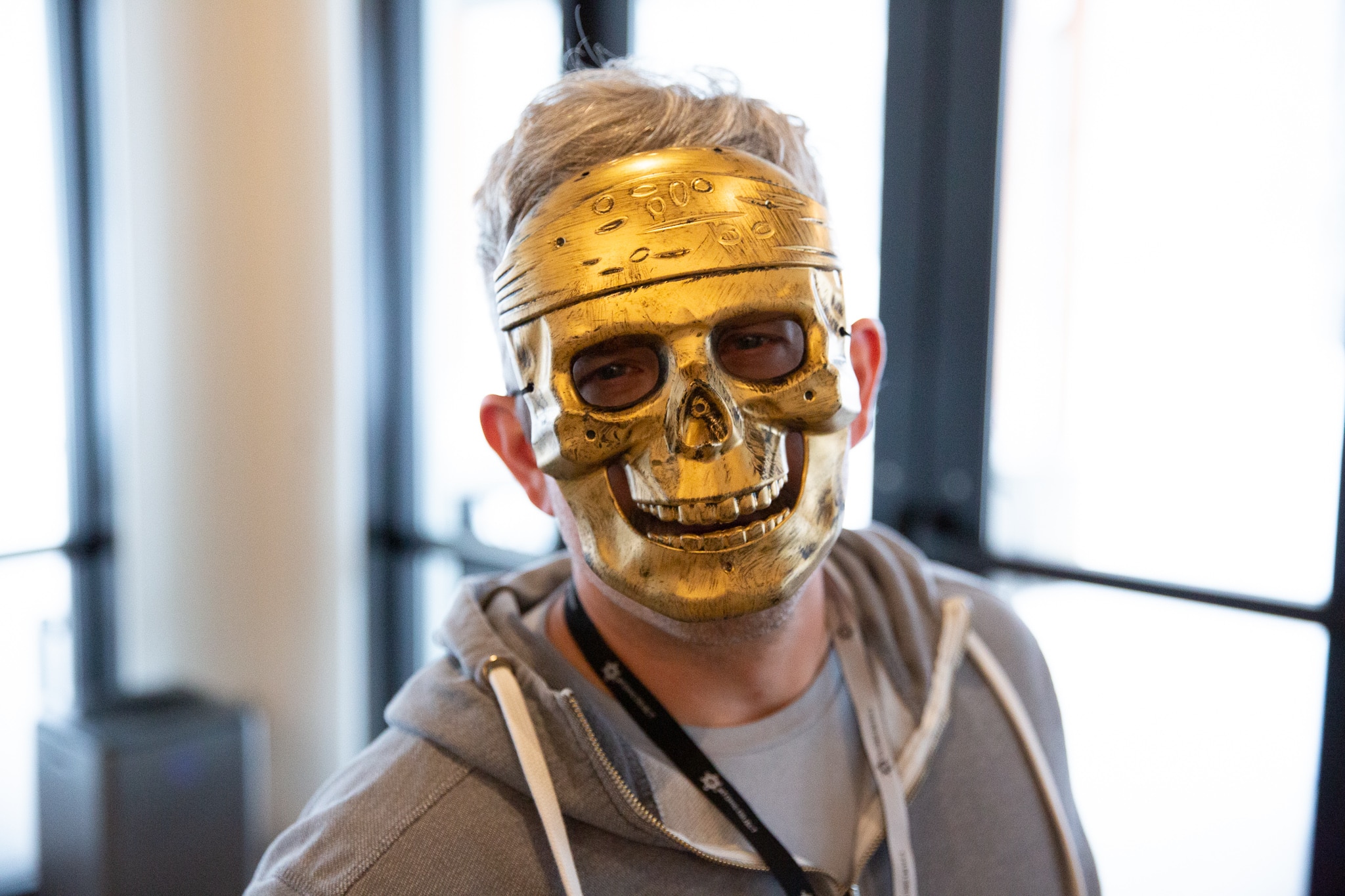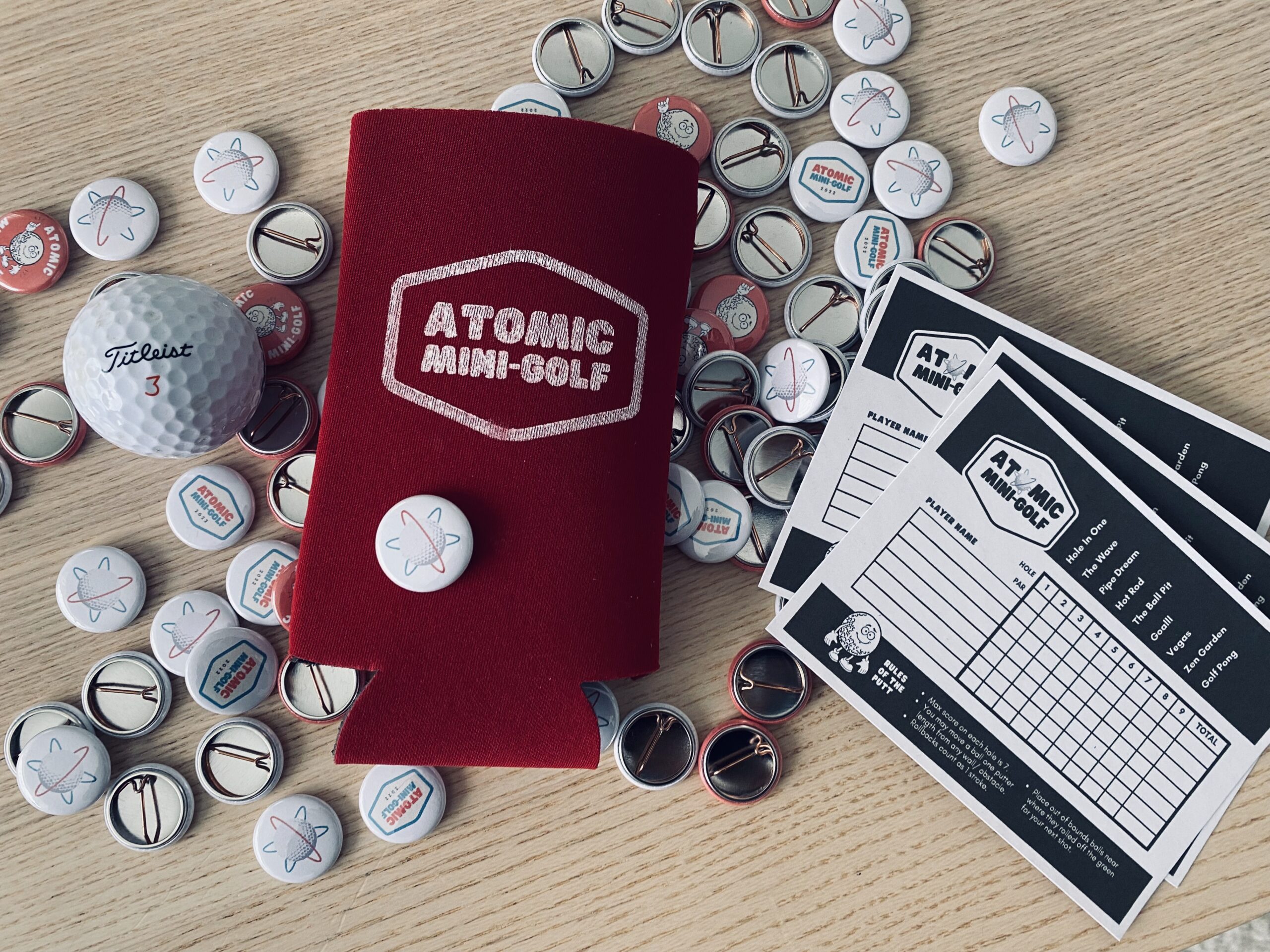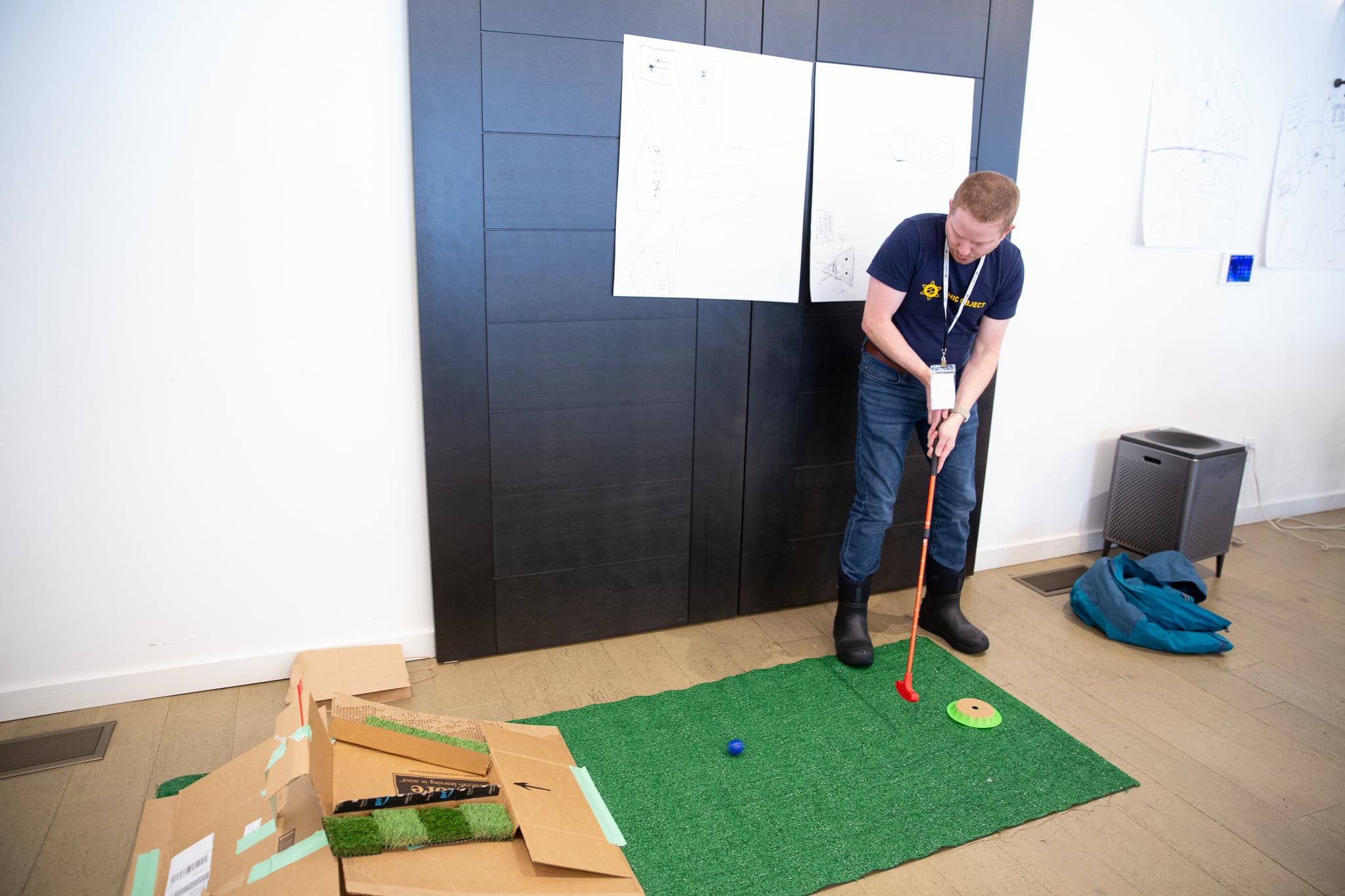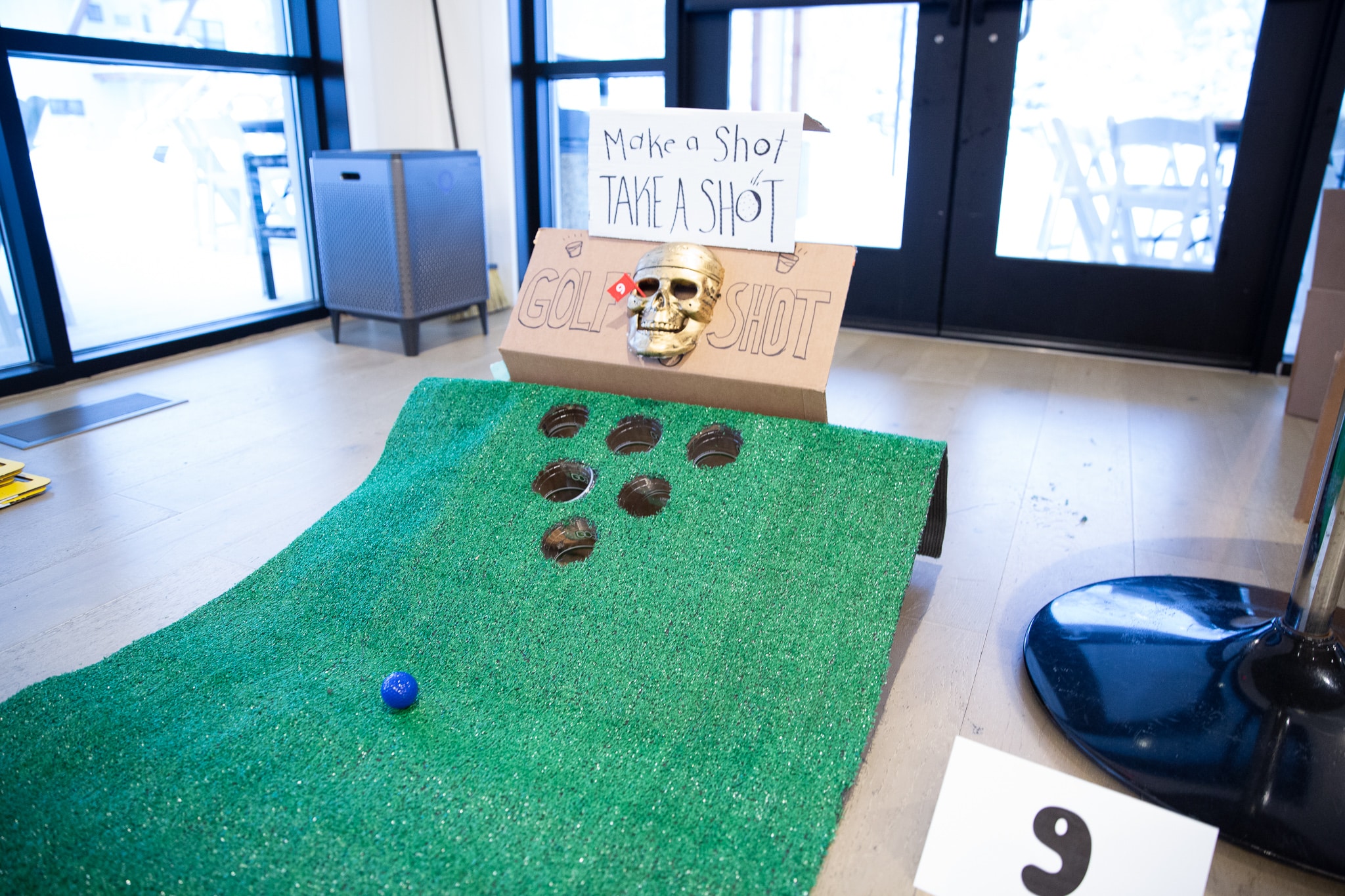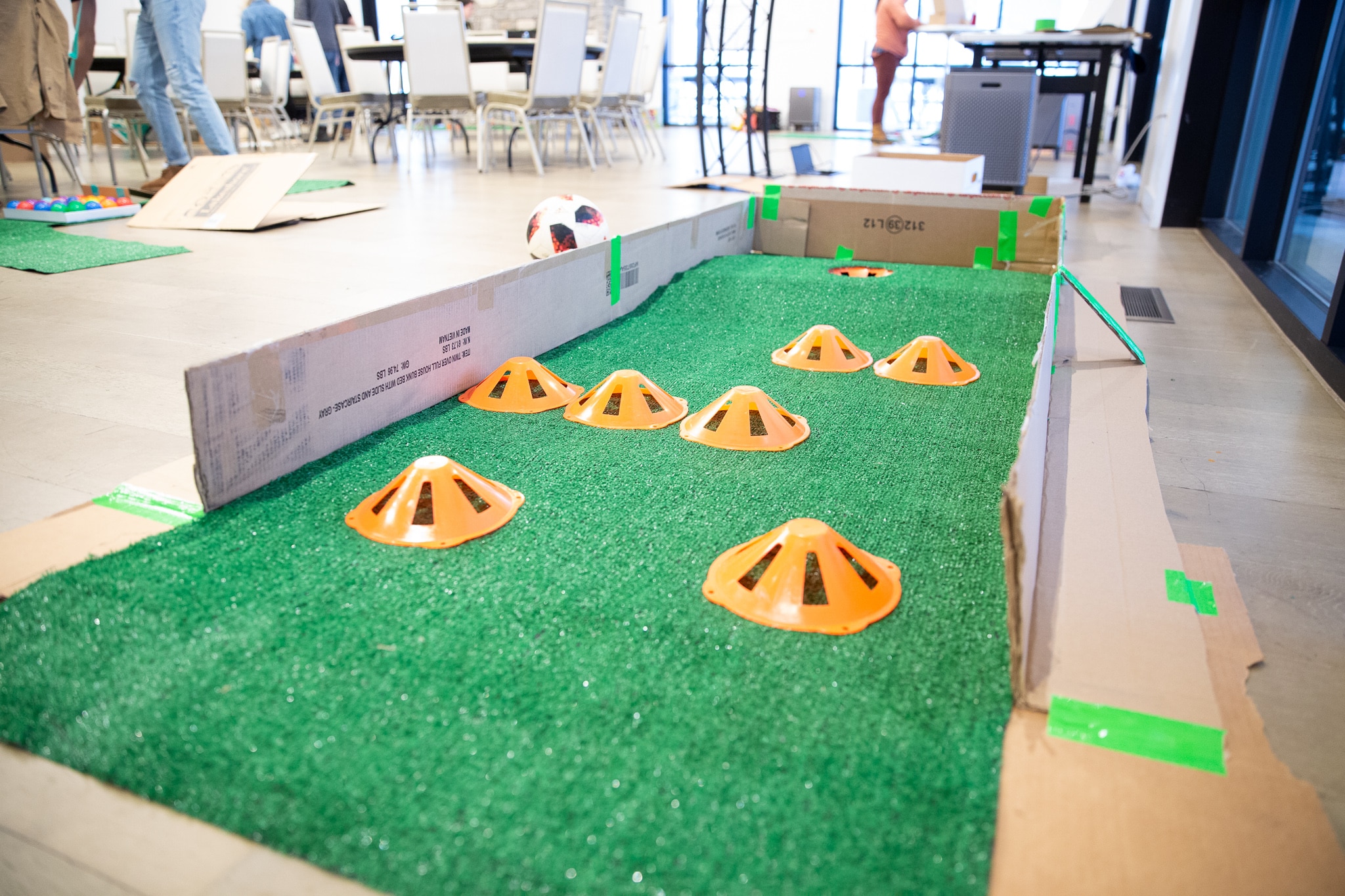At AtomicCon 2022, Atomic Object’s approximately every-other-year conference, our design team led a play-based hackathon that brought Atoms together across offices, disciplines, and seniority levels. We pitched a rapid prototyping challenge disguised as a reality competition: build a working mini golf hole with surprise constraints, unconventional materials, and a healthy dose of chaos. We handled end-to-end facilitation—from concept and branding to materials, instructions, and game structure. The result was more than an afternoon of fun: it created new friendships, fueled post-conference energy, and showed how play can be a tool for team connection and creative practice.
Chopped, But Make It Turf
AtomicCon is our internal conference at Atomic Object, held every 18 months to reconnect teams across our four offices. Mornings are filled with talks and presentations. Afternoons are reserved for fun events—low-pressure activities like jam sessions, board games, and yoga.
Our design team submitted a new kind of of event: a reality show-style prototyping challenge built around collaboration, cardboard, and chaos. That idea became Atomic Mini Golf. Our goal was to create a structured but silly challenge that mimicked our real-world design work—ideating, prototyping, iterating—while giving Atoms a shared experience.
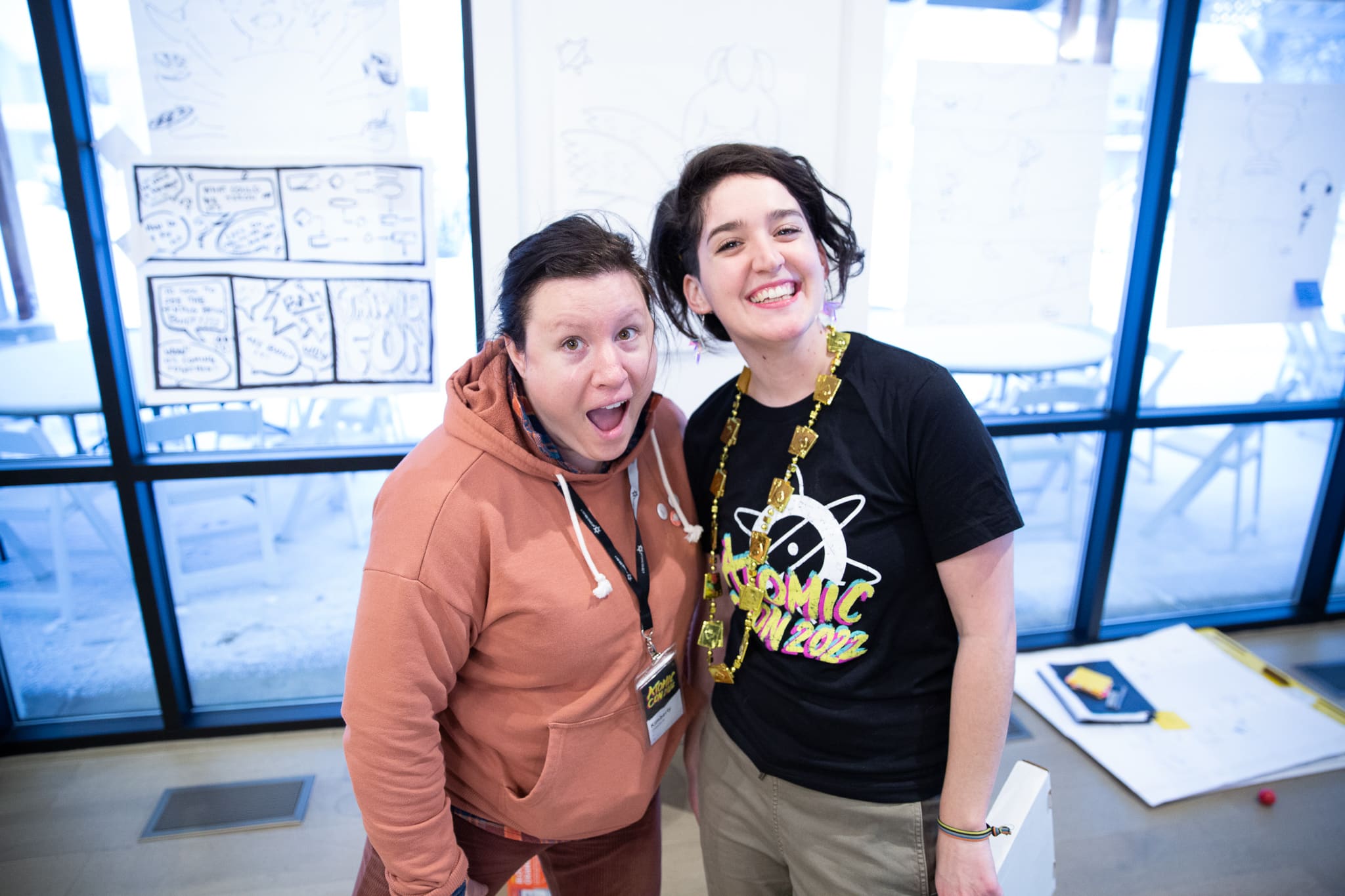
The idea started with a brainstorm from the design team. Once we had the green light, we ran with it—turning a one-sentence idea into a full-scale experience:
- We wrote instructions and challenge mechanics
- Designed a mini brand identity, including scorecards, koozies, and enamel pins
- Gathered all materials and supplies
- Sourced astro turf, golf balls and putters
- Facilitated the event, managed timing, and supported teams as needed
I led the logistics and planning, but it was a full-team production with everyone playing a role in bringing the chaos to life. This was a team effort, and no mini golf chaos would’ve been possible without the rest of the Atomic design crew. Each of us brought our own brand of magic to the floor:
Justin Interino (The Personality) — Our emcee and reality show host—kept the energy high and the commentary spicy
Kim Crawford (The Chaos Engine) — Facilitated mini-games, launched Nerf gun battles mid-build, and made sure nobody got too comfortable
Kyle Harris (The Hype Man) — Brought the putters, handed out the shots, kept morale (and volume) up
Ian Culver (The Immersive Builder) — Jumped into the trenches to help teams bring their weirdest ideas to life
Bryan Elkus (The Resident Photographer) — Documented the day with an eye for the moments that mattered.
Me (The Strategic One) — Designed the challenge format, wrote instructions, sourced materials, and put the pieces together.
It wasn’t just a workshop—it was a production. And somehow, it ran on time.
Why Mini Golf? A Rapid Prototyping Challenge in Disguise
Our event description said it all:
Do you enjoy ideating, prototyping, and collaborating—for fun?
Join a rapid prototyping workshop in the format of a reality competition show and race against the clock to build a mini putt-putt course with your team! Try new prototyping techniques with unconventional materials, play mini games, compete to win prizes, and complete surprise challenges. Oh, and there will be shenanigans!
We gave participants exactly that. Teams were challenged to build a playable putt-putt hole with limited materials, rotating constraints, and a ticking clock. We baked in fun through mini-games, surprise twists, and lighthearted competition—plus prizes, scorecards, and shenanigans.
Behind the fun, our goals were serious:
- Build new relationships across offices, roles, and seniority
- Reinforce creativity under constraints
- Give people a hands-on, low-stakes way to practice collaboration
- Create something that would make non-participants say, “I wish I signed up for that”

Challenges: Tight Space, Loud Energy, and Controlled Chaos
Atomic Mini Golf was intentionally messy. Teams were given just two hours to design and prototype a working mini golf hole using the following constraints:
- Randomly assigned teams of 3, mixing people from different offices and roles
- A shoebox containing a surprise challenge and secret ingredients ala Chopped
- A shared supply table with limited materials—cardboard, turf, glue guns, lights, tape, tinsel, etc
- Challenge modifiers, like “must include a tunnel” or “must have two holes”
- A workspace that doubled as the dining room
There were no instructions beyond the kickoff. Teams had to figure it out, fast. Some hoarded supplies. Others shared generously. Every team delivered something playable.
Design Strategy: From Idea to Interaction in Two Hours
Each team received their box of starter supplies. From there, the room erupted into controlled chaos—cutting cardboard, gluing turf, improvising ramps and tunnels. One team rigged up string lights. Another used markers to create an obstacle illusion. Every hole had a personality. When time was up, teams rotated through each other’s builds and played the holes together.
As other AtomicCon attendees returned from yoga and workshops, they entered the dining room to find nine fully built mini golf holes wedged between tables. The reactions were exactly what we hoped for.
We Heard a Lot of…
“Wait—what is happening in here?”
“This looks amazing.”
“I wish I had signed up for this.”
People played the holes after dinner and kept talking about them for weeks.
Outcome and Impact
- 6 playable mini golf holes with unique designs and constraints
- A two-hour, all-play event that helped people connect across teams, offices, and practices.
- A repeatable format for future AtomicCon activities
- Momentum that led to a follow-up challenge at AtomicCon 2024: a paper airplane competition
Atomic Mini Golf worked because it was more than fun—it was an exercise in collaboration, creativity, and constraint handling. Teams that had never worked together built something tangible in a short time, under pressure, with laughter and glue sticks.
It left people energized. New friendships formed across offices. People returned to work with inside jokes and shared stories. It also made design more visible as a strategic, facilitative force within the company—not just in pixels, but in how we build culture.
At the end, we rotated through the holes, played them all, and declared a winner. The prize? A pack of Arnie Palmers… which nearly got us kicked out of the venue. Worth it.
When the next AtomicCon rolled around, the ask was clear: “Can you do another one?”
Designing Culture Like We Design Software
Atomic Mini Golf reminded me that play can be a powerful tool. With just the right constraints, materials, and framing, you can take something simple—like building a golf hole—and turn it into a microcosm of our actual work: align quickly, test ideas, collaborate under pressure, and create something weird and memorable together.
For the design team, it was also a reminder that we don’t just design screens. We design experiences. We often talk about culture as an outcome of our work. I think it’s something we can design. And sometimes, all it takes is a box cutter and a roll of turf.
